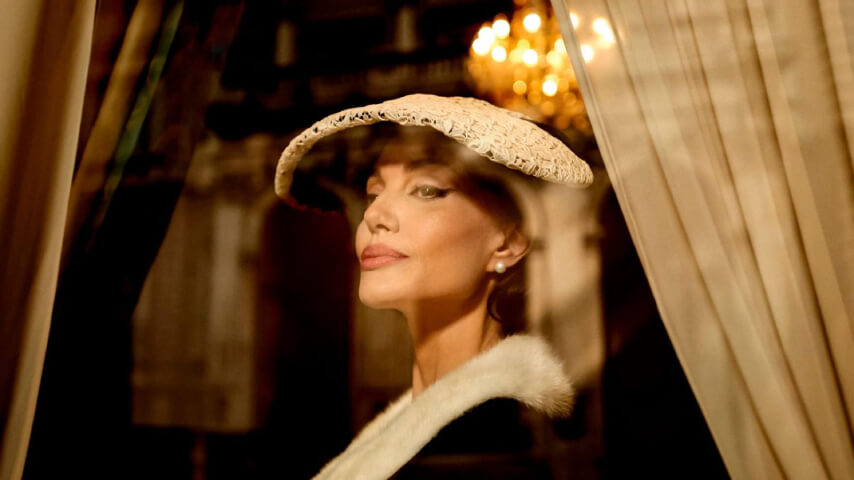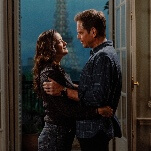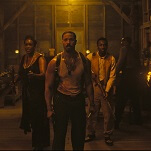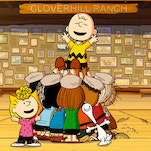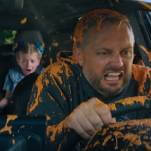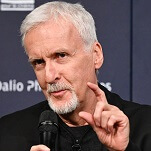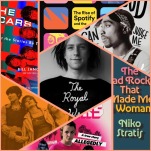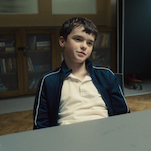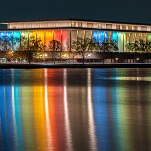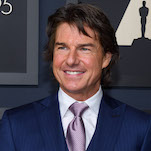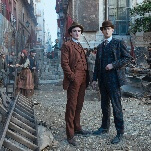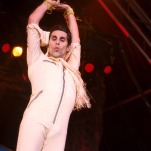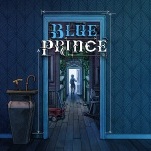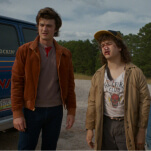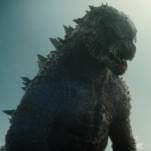It’s hard to watch Maria without thinking about the woman playing Maria. Watching Angelina Jolie in the Maria Callas biopic (the concluding film from director Pablo Larraín in his trilogy of bio-dramas about troubled female icons, following Jackie and Spencer) feels like seeing Jolie for the first time in a very long time, like witnessing the welcome return of an old friend. Her image has largely existed, of late, in tabloids about her difficult divorce from Brad Pitt and the alleged abuse he put her and her children through, or in interviews attempting to regain control of her own narrative. In spite of embodying another woman rocked by fame, abuse, and scandal in Maria, Jolie is full of poise, bravado, and sparkling grace. It’s star power, and Jolie confidently returns to commanding the screen as a difficult woman, after a rocky past decade playing mostly inhuman Disney characters.
If one criticism can be made of casting Jolie as the celebrated opera singer—who died young, tragically, and alone—it’s that it robs Callas of her striking Greek features, specifically her nose. Still, both women are and were a level of beautiful that seems to cross over into the supernatural. Maybe that was what Larraín was looking for in his biopic, which indulges in Callas’ legend more than reckons with her life. Jolie’s Callas haunts the rooms of her magnificent Parisian apartment, her thick, wild hair like a lion’s mane draped atop the nightgowns and floor-length cardigan she tends to live in when not leaving the house. It’s 1977, and Callas is obscured behind furniture. A white sheet covers her limp body lying upon the floor as her devoted house servants, Bruna (Alba Rohrwacher) and Ferruccio (Pierfrancesco Favino) look on. One week prior, the two of them were abiding by Callas’ absurd wishes to continuously change the location of her grand piano, while monitoring her usage of Mandrax. In America, Mandrax is more commonly known as a Quaalude, and Callas was abusing it heavily, having it mailed to her in secret.
In this depiction of the final week of a life cut too short, from a heart attack at the age of 53, cinematographer Edward Lachman’s camera trails Maria as she traipses through her enormous apartment like the granddaughter of Norma Desmond, speaking in riddles and cinematic non sequiturs. Maria’s Mandrax intake results in hallucinations, in which she’s being interviewed by a camera crew about her life, with the interviewer (aptly named Mandrax) played by Kodi Smit-McPhee.
It’s a framing device meant partly as an excuse to cut back and forth between Maria’s past and present as well as include some choreographed dream sequences, but it’s also presented as a grave mental health problem which plagues Maria. It’s an extreme and historically questionable choice, but the legacy of Maria Callas is that of a tortured diva who died for her art, so it’s the image that Larraín plays into. He encourages public legend of “La Callas,” making Maria’s final days a sad spectacle of theatrical deterioration rather than a genuine look at the human being at the myth’s core.
This is similar to the filmmaker’s approach in Spencer, where Maria writer Steven Knight imagined an alternate outcome for Princess Diana. Crucially, both Spencer and Maria are very different from the trilogy’s first film, Jackie, where screenwriter Noah Oppenheim uses the Kennedy widow’s tragedy as a door into her inner world. In Knight’s scripts for Spencer and Maria, though, the subjects seem utterly at the whims of their circumstances.
By 1977, Callas had retired from singing and lost her iconic voice; in Maria, she attends regular rehearsals in a futile attempt to regain her former glory. Jolie evokes Callas’ voice both in flashbacks and her declining present. Though the rationale for Callas’ vocal decline has been attributed to everything from her drastic weight loss to vocal overuse, it was most likely because Callas was suffering for years from a deteriorative muscular disease called dermatomyositis (possibly exacerbated by overuse and weight loss). Her pianist and vocal coach encourages her by telling her that he hears “hope in her voice,” but the spark which once lit up her throat has long since dimmed. Jolie’s performance of Callas’ singing is something of a marvel, and can’t simply be chalked up to some clever lip-syncing. To properly mirror the correct mouth movements, breathing, and posture, Jolie trained for several months with vocal coaches and opera singers. Although her singing is a fusion of her own voice mixed with recordings of Callas—a la Austin Butler and Elvis in Baz Luhrmann’s film—the physical movements of her throat and mouth are authentic because Jolie is actually singing opera.
As in Maria, some liked to claim the romantic notion that she died of a broken heart following the death of her long-time lover, Aristotle Onassis—who, as the eventual second husband of Jackie Kennedy, becomes another thread linking Larraín’s biopics. And while Callas loved Onassis, she admits that she felt inhibited by him, discouraged from singing under claims that he didn’t want to share her with the rest of the world. Having grown up under a controlling mother who forced her to sing for their family’s livelihood, Callas, in the era covered by the film, has finally reached a crucial point in her life where she wants to sing for herself. The tragedy is that this realization occurs as her life is quickly draining from her. Larraín and Knight articulate Callas’ desire for self-actualization but don’t allow her to put it into practice. Instead, her life is reduced to a fading existence and glimpses into her past that mirror black-and-white gossip pages in a newspaper.
Still, there is magic to Maria, which is inextricably adjoined to Jolie’s performance. Unlike Spencer, billed as a fable but akin to a nightmare, where Kristen Stewart’s Diana was an excruciating waif writhing around her Norfolk mansion uttering an accent so awful it bordered on farce, Jolie’s Callas is elegant and commanding. She’s erratic, melancholic, and quietly suffering, but she carries herself with the unshakeable grace of a queen. Jolie, with her own history as a star whose headlines have threatened to overshadow her talents, might be the ideal actress to embody this distraught diva behavior in the face of a public who encourages her return yet simultaneously aches to see her fail. Yet, Jolie is often more visible than the woman she’s playing. You see her history, what she’s been through, the roles that made her famous in the past. It never feels like Jolie has lost herself in the role; rather, you see Angelina Jolie playing Maria Callas.
But the dueling personas of Jolie and Callas adds a dimension of time-spanning kinship to Maria that it might not have had if it had starred an actress with less publicized personal baggage. Saddled with the pasts of two world-renowned stars, Maria is more like an emblem of the burden of fame than a dissection of the humanity at its core.
Director: Pablo Larraín
Writer: Steven Knight
Starring: Angelina Jolie, Kodi Smit-McPhee, Alba Rohrwacher, Pierfrancesco Favino, Valeria Golino
Release Date: November 27, 2024
